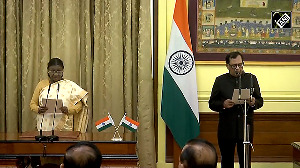While India's median age by 2015 will be 27 from the current 24, that of China will reach 37 from 32. Favourable demographics, along with structural reforms and globalisation will drive the country to a sustained +8 per cent economic growth, according to a JM Morgan Stanley study.
The second edition of the 'India and China: New Tigers of Asia' study, says that India can maintain the high-growth phase longer than East Asia as its age-dependency ratio will continue to decline till 2035 - that is, the share of working-age population will continue to rise.
"The economic impact of India's demographic trends should improve further as the age-dependency ratio falls to 55 per cent by 2010 and to 52 per cent by 2015 from an estimated 60 per cent at present," Chetan Ahya, executive director, JM Morgan Stanley Securities, said.
The favourable demographics would also push India's aggregate savings to over 33-35 per cent of GDP over the next five years, from the past three years' average of 28.6 per cent, Ahya said.
"This increase in savings and, correspondingly, the investment-to-GDP ratio to above 35 per cent should ensure a shift in India's growth to a sustained rate of +8 per cent," Ahya said. On the other hand, over the next 10 years China's growth rate would moderate from a high base.






